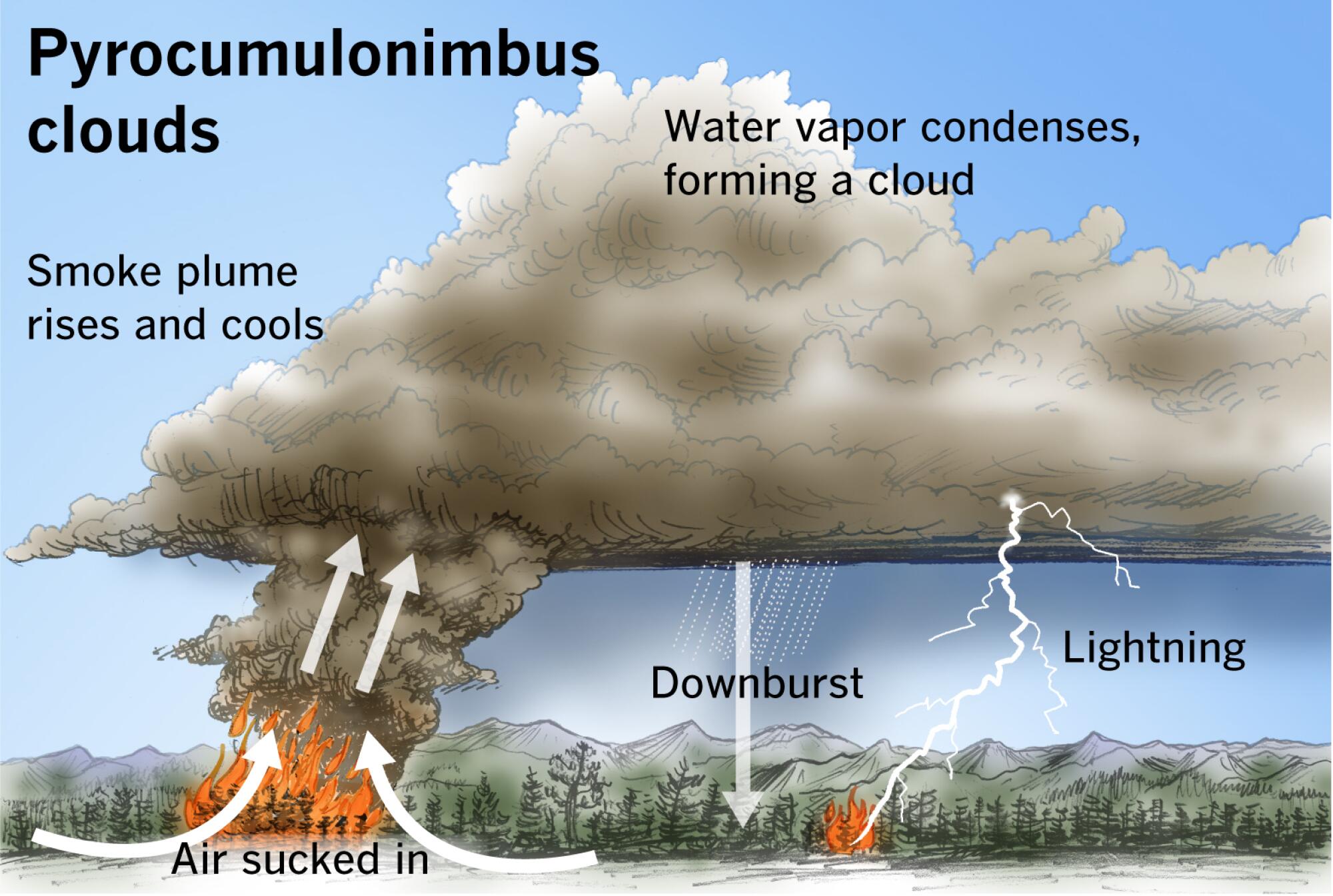During the first full weekend of September, when the fire had grown to over 20,000 acres and was only 3% contained, one San Bernardino County resident saw the sky look like this:just like an atomic bomb exploded,
On a basic level, this makes sense: By that time, the line fires had already released more energy into the atmosphere than a dozen atomic bombs. And just as nuclear explosions create a distinctive mushroom cloud, uncontrolled wildfires can be powerful enough to create their own weather.
When wood and other vegetation burn, they produce four main compounds: carbon dioxide, smoke (which itself is a mixture of toxic elements such as carbon monoxide, methane, benzene and many others), heat and water vapour. Of these, carbon dioxide is the least relevant to local weather – while it does play a major role in the global climate, this is more due to its long lifetime rather than its immediate potency.
The most notable consequence of smoke emission is its dangerous impact on human health.
Plumes of smoke can travel hundreds or even thousands of miles with the wind. In addition, smoke aerosols block and scatter sunlight, creating the unrealistic “red sun” effect seen in frightening photos on social media; their optical properties also suppress rainfall in downwind locations, which (in the long term) can further fuel fires due to dry conditions.
Smoke from the line fire (right) and the airport fire (left) obscures the sun and turns the sky an eerie orange.
(Gina Ferrazzi/Los Angeles Times)
The next byproduct of a fire is heat – like the burner in a hot air balloon, a wildfire makes the lower layer of the atmosphere less dense and therefore rises. As the air above the fire rises, air from outside comes in to take its place, providing the fire with oxygen that helps it continue to burn.
If a fire is powerful enough, it can create a “firestorm.” This happens when all the air around the fire is directed toward the center of the fire, causing a feedback effect: more oxygen creates more intense flames, which in turn draw in even more oxygen.
These winds have a mixed effect on the fire’s ability to spread – on the one hand, gusts of wind are directed inward, which means sparks are less likely to be pushed outward. On the other hand, strong winds can catch burning embers, tossing them into unburned material, where they can cause “spot fires” many miles away from the fire line.
In addition, a firestorm can radiate such intense heat that it becomes impossible for firefighters to work in the vicinity. Firestorms have been observed not only during wildfires but also during World War II when bombed cities – such as Dresden, Germany and Hiroshima, Japan – experienced far more destruction from the resulting fires than from the initial bombing.

The last component is water vapor.
As the hot air rises into the atmosphere, the water vapor from the combustion condenses, aided by the presence of smoke particles that act as “condensation nuclei” and allow the water to form droplets. This condensation creates more heat, which leads to even more powerful convection, and the end result is known as a pyrocumulus (or, in more extreme cases, pyrocumulonimbus) cloud.
These clouds often spell trouble for firefighters trying to control a fire — not only because they indicate that the fire is growing, but also because dangerous conditions and low visibility within the cloud prevent aircraft from being used to fight the fire. In addition, these clouds can cause frequent lightning strikes, which ignite new fires in the area.
One saving grace is that pyrocumulus clouds can produce rain, which in some cases will suppress the very fire that created them. However, depending on wind conditions, this rain will sometimes evaporate before it reaches the ground due to the hot, dry atmosphere surrounding the fire.
If this happens, it can produce a “downburst” as cold, dense air descends rapidly from the cloud. Like an updraft, this provides fresh, oxygen-rich air to the fire; unlike an updraft, a downburst causes winds to radiate away from the center of the fire, causing it to spread rapidly in several directions at once.

Pyrocumulonimbus is the ultimate extreme pyrocumulus cloud.
(Paul Duginski/Los Angeles Times)
What does all this mean for Southern California?
Fortunately, massive firestorms are nearly unheard of in the region, partly because the region’s narrow valleys and strong winds tend to direct gusts – and therefore fires – in specific directions. Less fortunately, both factors can increase the speed of fire spread and promote pyrocumulus formation.
Structures located on top of hills and peaks are particularly at risk, as fires spread eight times faster as they climb steep slopes than on flat ground, and lightning from pyrocumulonimbus clouds is more likely at higher elevations.
with the National Inter-Agency Fire Center Forecast of higher than normal fire probability As fires continue to increase along the Southern California coast through the end of the year, there is a strong possibility that more wildfires will be experienced across the region in the coming months.
Interactions between a wildfire and its environment can cause rapid and unpredictable changes in fire direction and intensity, so it is important for residents to remain vigilant during high-risk periods.
















